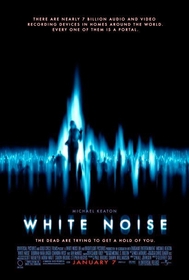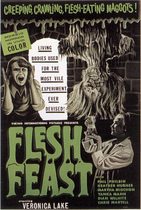Our editor-in-chief Nate Yapp is proud to have contributed to the new book Hidden Horror: A Celebration of 101 Underrated and Overlooked Fright Flicks, edited by Aaron Christensen. Another contributors include Anthony Timpone, B.J. Colangelo, Dave Alexander, Classic-Horror.com's own Robert C. Ring and John W. Bowen. Pick up a copy today from Amazon.com!
White Noise (2005)
I am willing to accept that most every attempt at horror that Hollywood puts out is going to be hack. Above this, I can still usually find something at least mildly enjoyable in the typical Hollywood horror flick. This film? Not so much. For a film in which I had such low expectations going in, I still came out disappointed due to directorial incompetence and the fact that the creators were absolutely clueless of the potential of the subject matter.
The story appears to be -- or at least, God, I hope it is the case -- the victim of very bad post-production editing, because it has no cohesion whatsoever. Michael Keaton plays a man who just lost his wife rather tragically. Through the help of a gentlemen who is well-versed in communicating with the dead through the “white noise” on television, radios, etc, he attempts to contact his wife. His wife, for no reason that I could see, starts transmitting images to him of local people in tragic situations so that he can go save them before they die. Oh, and people around him start to die in some sort of a pattern, too. And, silly me, I thought this would actually make sense or at least come together in some fashion in the end, but instead I was treated to an anti-climatic conclusion that didn’t answer a damn thing and in fact created more plot holes.
The problem with this movie is that the director was clearly trying to avoid making the typical hack Hollywood film, while still appealing to people who enjoy both the American horror film and the Japanese-brand of horror film. Mixing the two techniques simply does not work as American horror films are intensity-driven (big “jump out at you” scares) while the Japanese method is more subtle (“it’s lurking, but you can’t see it” scares). So, we were left with 90-minutes of conflicting horror techniques done to minimal effectiveness -- which is a shame, because if he chose one or the other, some of the scares could have been real. Instead it ended up like seeing Ringu and the original A Nightmare on Elm Street on the screen at the same time… .great by themselves, a trainwreck when mixed.
This unfortunate blend of conflicting horror styles was seen in the plot as well. Japanese horror has really excelled at the “frightening nature of the unknown.” They only tell you enough to keep the story going, and tend to conclude their films just enough so the viewer is satisfied, but still leaving enough unanswered questions to keep you intrigued long after you finish the film. American films tend to be the polar opposite in that the films leave you guessing through the whole film, but everything is answered at the end….which leaves you equally as intrigued as you spend time reflecting on what you THOUGHT was going to happen. White Noise tried to do both by giving you little to no indication where the film was going during the movie, and when you got to the end you still went “Huh?” I don’t mind a “Huh?” moment at the end of the film, or going “Huh?” throughout the entire film until the end, but it’s entirely pretentious to ask the audience to do both. Especially as this was clearly not an “artistic-integrity” play, but more of an “incompetence” play. I got the feeling after the editor watched this film, he found out it made no sense whatsoever, and just started dropping in random scenes and characters (one character in particular has no purpose other than offering one line of dialogue which is supposed to explain the whole conclusion) just to try to give some level of cohesion. And conceptually, it does make sense. The execution of the concept was poor, and I was left holding way too many “Whys?” when the movie ended.
And just a comment…who the hell decided that bathrooms were the undisputed portal to the underworld? The next director who tries to pull the “brushing teeth, bends down to spit, and the demon appears in the mirror when he brings his head up” or the “demons walking past the bathroom while brushing his teeth,” is going to cause me to dropkick my television screen.
Now, back to your regularly scheduled, scathing review.
Perhaps the most tragic thing about this film is that it clearly had potential. In fact, with a couple rewrites and stronger horror techniques, the film would probably have been at least as good as The Mothman Prophecies (an above-average, and highly underrated horror film with a similar plot line) and could in fact have been phenomenal. The concept of spirits trying to communicate with us via household electronics is creepy and effective. And Michael Keaton has the right amount of believability for the character of a grieving husband who loses his sense of logic and tries to communicate with the dead. As much as I hate the concept of remakes, this movie would be a perfect candidate in a couple of years.
If you are thinking about renting this film, really, don’t bother. It will be nothing you haven’t seen already, and will only frustrate you to no end. If it’s already sitting on your shelf of rented DVDs, I’m sorry I couldn’t get to you sooner. If it’s any consolation, the documentaries of supposedly “real” transmissions from behind the grave on the DVD are entertaining enough. And if you happened to rent the VHS... well, I got nothing. Hey, it might make a decent coaster.








